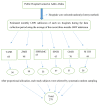Predictors of time to full enteral feeding in low birth weight neonates admitted to neonatal intensive care unit: a prospective follow up study
- PMID: 38245699
- PMCID: PMC10799381
- DOI: 10.1186/s12887-024-04545-0
Predictors of time to full enteral feeding in low birth weight neonates admitted to neonatal intensive care unit: a prospective follow up study
Abstract
Background: Survival of LBW infants has increased in recent years because of novel perinatal interventions, but the introduction and advancement of enteral feeds for low birth weight infants is challenging. In Ethiopia the proportion of low birth weight infants is thought to be 17.3%. The purpose of this study was to determine the time to full enteral feeding (FEF) and its predictors in LBW neonates admitted to neonatal intensive care unit in selected hospitals of Addis Ababa, Ethiopia.
Method: An institutional based prospective follow up study was conducted from March 15 to June 15, 2022 among 282 LBW neonates admitted to six randomly selected hospitals. Both primary and secondary data was used by interviewing mothers and prospective medical chart review of neonates. The Cox regression model was used and variables having a p-value less than 0.05 with 95% CIs in a multivariable analysis were declared as statistically significant association with time to full enteral feeding.
Result: Out of 282 neonates involved in this study, 211 (74.8%) of them reached at FEF. The overall median time to full enteral feeding was 5 days. Predictors significantly associated with time to full enteral feeding were educational level, birth weight, cesarean delivery, hospital acquired infection, being on antibiotics, age at initiation of trophic feeding, routine gastric residual evaluation and NICU location (hospital).
Conclusions: This study demonstrated the difficulty of understanding which low birth weight neonate will attain FEF in a timely manner and factors that affect time to FEF. There is a delay in full enteral feeding achievement among low birth weight neonates and there is a great deal of heterogeneity of practice among health care providers regarding feeding of infants as it was evidenced by a variation in feeding practice among hospitals. Nutrition should be considered as part of the management in neonatal intensive care units since low birth weight neonates are developing edematous malnutrition while they are in the NICU. There should be standard feeding protocol to avoid heterogeneity of practice and additional study should be conducted for each categories of GA and BW with long follow up time.
Keywords: Ethiopia; Full enteral feeding; Low birth weight; Predictors; Preterm.
© 2024. The Author(s).
Conflict of interest statement
The authors declare no competing interests.
Figures






References
-
- OHCHR | Home [Internet]. [cited 2021 Dec 18]. Available from: https://www.ohchr.org/EN/pages/home.aspx.
-
- Gidi NW, Goldenberg RL, Nigussie AK, McClure E, Mekasha A, Worku B, et al. Incidence and associated factors of extrauterine growth restriction (EUGR) in preterm infants, a cross-sectional study in selected NICUs in Ethiopia. BMJ Paediatr Open. 2020;4(1):e000765. doi: 10.1136/bmjpo-2020-000765. - DOI - PMC - PubMed
Publication types
MeSH terms
LinkOut - more resources
Full Text Sources

